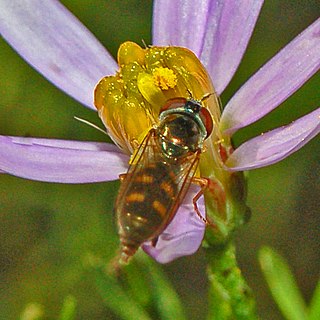
Syrphus ribesii is a very common Holarctic species of hoverfly. Its larvae feed on aphids. In common with many other species of hoverfly, males have the eyes meeting on the top of the head, whilst females have their eyes widely separated.

Platycheirus scambus is a species of hoverfly. It is a Holarctic species.

Platycheirus peltatus is a Palearctic species of hoverfly.

Platycheirus scutatus is a very common species of hoverfly. It is a Holarctic species.

Platycheirus albimanus is a common widespread species of hoverfly. A holarctic species its range includes Greenland, Iceland, Britain, mainland Europe, Russia, across Siberia to the pacific coast, the Philippines, Alaska, western Canada and United States.

Platycheirus granditarsus, the Hornhand Sedgesitter, is a species of hoverfly. It is found in many parts of Britain North America and Europe. Typical habitat includes marshy meadows and ditches, where it can be found between May and October, though it is at its commonest between July and September. The most distinctive feature of this fly is the red-orange abdomen most easily seen as it takes off or alights.

Platycheirus manicatus is a species of hoverfly. It is found across the Palearctic and in Alaska.

Platycheirus rosarum is a species of hoverfly found in the Holarctic realm. Like its close relative Platycheirus granditarsus, it can be found in marshy meadows and ditches; indeed, the two species can often be found together. The flight time is between May and October, though it peaks in abundance in June and July.

Platycheirus ambiguus is a small widespread species of hoverfly found across the Palearctic from Ireland to Japan. A spring species found in flight in April and May, it visits spring-flowering trees and shrubs, e.g., Prunus spinosa in deciduous woodland and scrub.

Platycheirus amplus the Broadhand Sedgesitter is a rare Holarctic species of hoverfly found in wetlands, fens, moorland streams and bogs.

Platycheirus angustatus is a species of hoverfly. It is found in many parts of the Palearctic, and in the Nearctic.

Platycheirus discimanus, the Yellowfoot Sedgesitter is a small species of hoverfly. It is found across Europe and the Palearctic and in North America.

Platycheirus immarginatus, the Comb-legged Sedgesitter, is a common species of hoverfly. It is found in parts of northern Europe and northern North America.
Platycheirus nielseni is a Holarctic species of hoverfly.
Platycheirus perpallidus is a species of hoverfly. It is a Holarctic species.

Platycheirus aeratus, commonly known as Coquillett's sedgesitter, is a species of hoverfly.

Platycheirus alpigenus is a rare high mountain species of fly. Platycheirus can remain nearly motionless in flight. Adults are also known as flower flies for they are commonly found on flowers from which they get both energy-giving nectar and protein rich pollen. Larvae unknown for this species but Platycheirus are generally aphid predators.

Platycheirus brunnifrons, sometimes known as the copperhead sedgesitter, is a hoverfly found in high-altitude localities in Finland, Austria, France, Switzerland, Spain, Macedonia, Northeast Russia, and Alaska. It's larvae have not been identified. Adults feed on pollen and nectar primarily Salix sp.

Platycheirus ciliatus, the Pacific sedgesitter, is a species of hoverfly. They have been found in Canada: British Columbia. USA: Alaska, California, Oregon, Washington. Larvae are unknown.

Platycheirus clausseni Claussen's Sedgesitter is a fly in the family Syrphidae or hoverfly. It is distributed throughout the Alps, the Altai mountains in Siberia, and Colorado, United States.

























